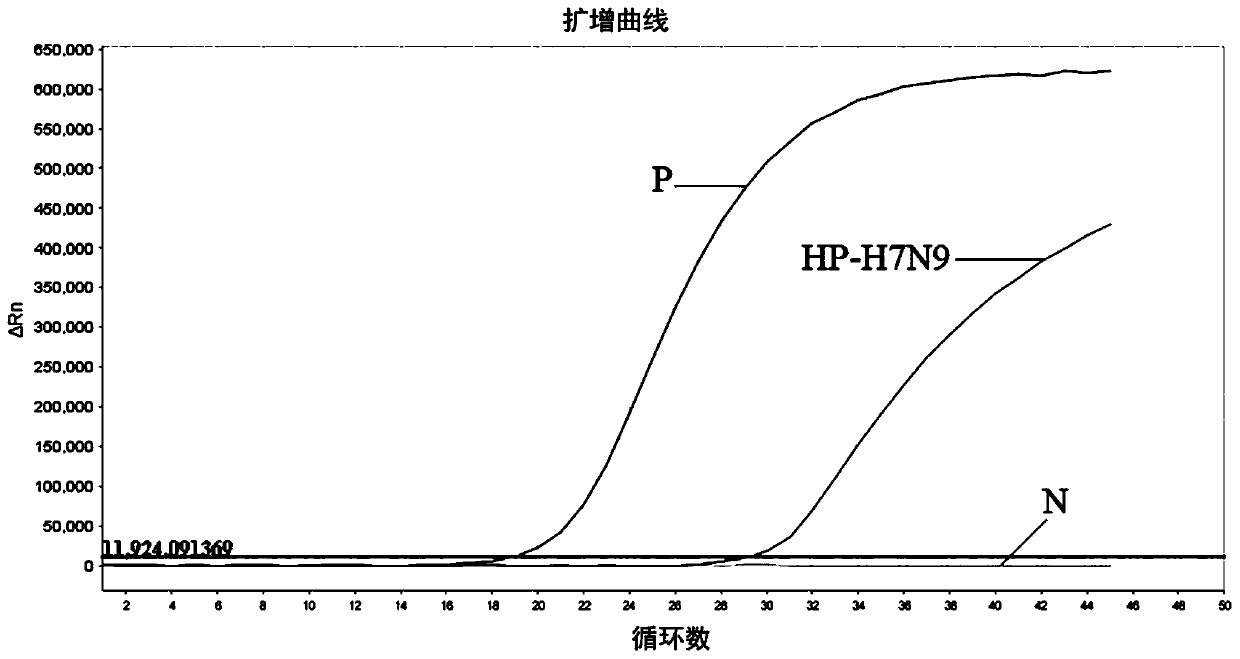Fluorescent RT-PCR primer, probe and method for detecting highly pathogenic H7N9 avian influenza virus
A technology of RT-PCR and avian influenza virus, which is applied in the field of fluorescent RT-PCR primers, can solve the problems of not being able to identify highly pathogenic H7N9 strains, and achieve the effect of ensuring public health safety and protecting production safety
- Summary
- Abstract
- Description
- Claims
- Application Information
AI Technical Summary
Problems solved by technology
Method used
Image
Examples
preparation example Construction
[0044] Preparation of positive control: Submit the target fragment to BGI for gene synthesis, and make recombinant plasmid WHC183644-75 as a positive control. The sequence of the target fragment is as follows:
[0045] CTATCAACTTAAATTGTTGGTTGGTTTTTGCTATAAGCCGGTTTAATTTCCCTGTTATTTGATTAATTGCCGATTGAGTGCTTTTGTAATCTGCAGCAGTTCCCTCTCCCTGTGCATTCTGGTGTCTGAAACCATACCAACCATCAATTAGGCCTTCCCATCCATTTTCAATGAAACCCGCTATAGCACCAAATAGGCCTCTCGCAGTCCGTTTTCCCTTTGGAACCTCAGGAACATTCTTCATCCCTGTTGCCAGCAGAAGACTCCTTTGCTTAACATATCTCGGACATTTTCCAACTGCCCTGCTATCTATGTTCTGAAATGGCAAGT(SEQ ID NO:4)。
[0046] Preparation of negative control: SPF chicken embryo allantoic fluid was aseptically taken, and viral nucleic acids such as common influenza A virus, IBDV, IBV and NDV were tested, and the results were all negative, which was used as a negative control.
Embodiment 1
[0047] Example 1 Primers and Probes
[0048] After screening a large number of designed primers and probes, it was found that primers 75F, 75R and probe 75P had the best effect in detecting HP-H7N9 by RT-PCR, and their base sequences are shown below.
[0049] Table 1 Fluorescent RT-PCR primers and probes for highly pathogenic H7N9 avian influenza virus
[0050]
Embodiment 2
[0051] Example 2 Viral RNA Extraction
[0052] (1) Take n sterilized 1.5mL Eppendorf tubes and number them, where n is the sum of the tested sample, positive control and negative control (positive control and negative control are marked in the kit).
[0053] (2) Add 600 μL of lysate to each tube, add 200 μL each of the tested sample, negative control, and positive control, and then add 200 μL of chloroform, shake and mix on the mixer for 5 seconds (not too strong, so as not to produce an emulsified layer, you can also use Mix by hand inversion). Centrifuge at 4°C, 12 000r / min for 15min.
[0054] (3) Take the same number of sterilized 1.5mL Eppendorf tubes as in step (1), add 400 μL of isopropanol (pre-cooled at -20°C), and mark it. Pipette the supernatant from each tube in step (2) of this standard and transfer it to the corresponding tube. The supernatant should be pipetted at least 500 μL, and the middle layer cannot be suctioned out. Invert and mix well.
[0055] (4) Cen...
PUM
 Login to View More
Login to View More Abstract
Description
Claims
Application Information
 Login to View More
Login to View More - R&D
- Intellectual Property
- Life Sciences
- Materials
- Tech Scout
- Unparalleled Data Quality
- Higher Quality Content
- 60% Fewer Hallucinations
Browse by: Latest US Patents, China's latest patents, Technical Efficacy Thesaurus, Application Domain, Technology Topic, Popular Technical Reports.
© 2025 PatSnap. All rights reserved.Legal|Privacy policy|Modern Slavery Act Transparency Statement|Sitemap|About US| Contact US: help@patsnap.com



